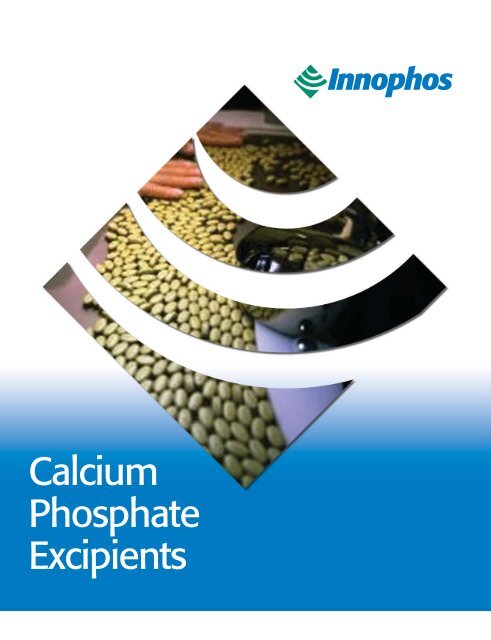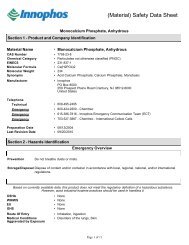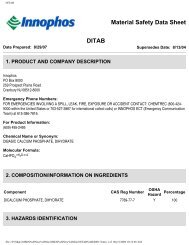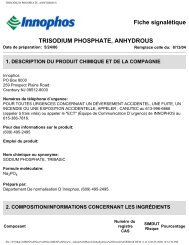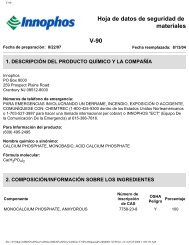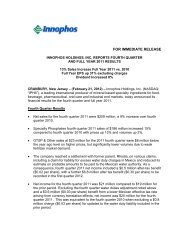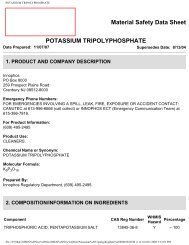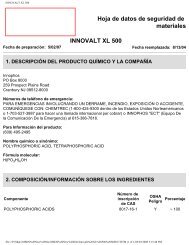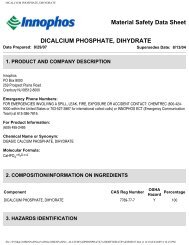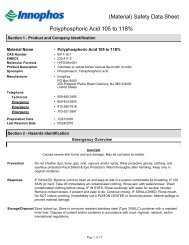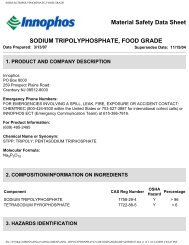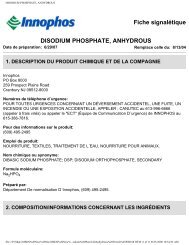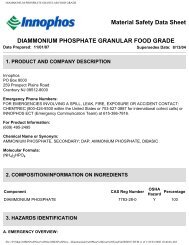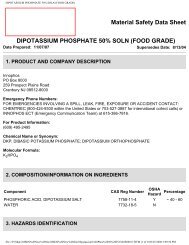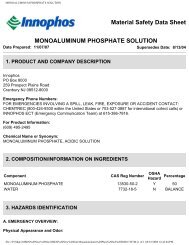Calcium Phosphate Excipients - Innophos
Calcium Phosphate Excipients - Innophos
Calcium Phosphate Excipients - Innophos
You also want an ePaper? Increase the reach of your titles
YUMPU automatically turns print PDFs into web optimized ePapers that Google loves.
<strong>Calcium</strong><br />
<strong>Phosphate</strong><br />
<strong>Excipients</strong>
<strong>Calcium</strong><br />
<strong>Phosphate</strong><br />
<strong>Excipients</strong>
TABLE OF CONTENTS<br />
Page Number<br />
Clinical trials<br />
demonstrate the<br />
positive effect<br />
of calcium and<br />
phosphorus<br />
supplimentation<br />
in osteoporosis<br />
sufferers who<br />
receive bone<br />
building therapy.<br />
SECTION 1: THE LEADER IN CALCIUM PHOSPHATES<br />
The Leader in <strong>Calcium</strong> <strong>Phosphate</strong> <strong>Excipients</strong> ...............1<br />
An Introduction to <strong>Calcium</strong> <strong>Phosphate</strong>s .........................1<br />
Manufacture of <strong>Calcium</strong> <strong>Phosphate</strong>s ...............................2<br />
SECTION 2: METHODS FOR THE PREPARATION OF TABLETS<br />
Methods for the Preparation of Tablets...........................3<br />
SECTION 3: PHYSICAL AND CHEMICAL PROPERTIES<br />
Physical and Chemical Properties.....................................5<br />
Formulas and Nomenclature ..............................................5<br />
<strong>Calcium</strong> and Phosphorus Content....................................6<br />
Scanning Electron Photomicrographs..............................7<br />
Particle Size Distributions.....................................................9<br />
Adsorption Isotherm..............................................................9<br />
Moisture ..................................................................................10<br />
Compatibilities and Stability .............................................10<br />
Thermal Behavior .................................................................11<br />
Solubility..................................................................................11<br />
Density .....................................................................................12<br />
SECTION 4: TABLETING PROPERTIES<br />
<strong>Calcium</strong> <strong>Phosphate</strong>s in Direct Compression ...............13<br />
Direct Compression with A-TAB ® .....................................13<br />
Direct Compression with DI-TAB ® ...................................15<br />
Direct Compression with TRI-TAB ® .................................16<br />
Direct Compression Tableting with TCP-DC ...............17<br />
Disintegration of <strong>Calcium</strong> <strong>Phosphate</strong> Tablets .............18<br />
Consolidation of <strong>Calcium</strong> <strong>Phosphate</strong>s ..........................18<br />
Flow of <strong>Calcium</strong> <strong>Phosphate</strong>s............................................18<br />
Lubrication of Tablets with <strong>Calcium</strong> <strong>Phosphate</strong><br />
Formulations ..........................................................................19<br />
Tooling <strong>Phosphate</strong> Formulations.....................................20<br />
Loading Capacity of <strong>Calcium</strong> <strong>Phosphate</strong>s ....................20<br />
SECTION 5: COMPLETE SERVICE SUPPORT<br />
Complete Service Support.................................................21<br />
Units of measurement, definition of terms .................23<br />
Bibliography ...........................................................................24
THE LEADER IN CALCIUM PHOSPHATES<br />
<strong>Innophos</strong> is well positioned to meet all your needs for high-quality calcium phosphates. We have been<br />
manufacturing calcium phosphates at our Chicago Heights, Illinois manufacturing plant since the 1930s.<br />
Because of our high commitment to meeting the pharmaceutical industry's need for high performance<br />
excipients, we have continually made improvements in our products and our plant's manufacturing<br />
capability. We also have continued to add to our product line to establish our positions<br />
as the market leader in calcium phosphates.<br />
1<br />
Uncompromising Quality<br />
Each product is manufactured under carefully<br />
controlled processing conditions to minimize<br />
lot-to-lot variations in pharmaceutical tableting.<br />
These products are manufactured under the Food<br />
and Drug Administration and Good Manufacturing<br />
Practice guidelines for bulk pharmaceuticals. A drug<br />
master file (DMF) is available for each product.<br />
Complete Technical Support<br />
Our laboratories and technical staff can provide<br />
you with ongoing support in your pharmaceutical<br />
application of calcium phosphate excipients.<br />
Why we prepared this guide.<br />
The information on the following pages has been<br />
compiled to offer you an overview of the general<br />
chemical, physical and tableting properties of<br />
calcium phosphates.<br />
We encourage you to use this guide as reference<br />
for your own product line, as well as a technical<br />
resource for calcium phosphates in general. If you<br />
have questions about an existing product or a<br />
potential application, please do not hesitate to<br />
call our technical information number.<br />
This guide, our product quality and our ongoing<br />
product development programs are all evidence<br />
of our commitment to meeting the needs of<br />
customers who use calcium phosphates as<br />
pharmaceutical ingredients.<br />
An Introduction to <strong>Calcium</strong> <strong>Phosphate</strong>s<br />
<strong>Calcium</strong> phosphates have a number of fundamental<br />
properties which make them ideal for solid dosage<br />
formulations with a wide range of actives:<br />
◆ white color<br />
◆ stability<br />
◆ insolubility<br />
◆ will not case harden<br />
◆ excellent disintegration with disintegrants<br />
◆ compatible with a wide range of actives<br />
◆ provide a source of calcium and phosphorus<br />
<strong>Calcium</strong> phosphates are often used in<br />
pharmaceutical tableting...<br />
◆ with soluble drugs<br />
◆ to improve flow<br />
◆ to densify a blend<br />
◆ in ordered mixing<br />
◆ to reduce production cost<br />
◆ in direct compression formulations<br />
◆ in wet granulations for ease of handling<br />
<strong>Calcium</strong> phosphates find wide application as<br />
excipients in direct compression and wet<br />
granulation tableting. They're used as flow<br />
agents, as a source of calcium and phosphorus<br />
and are used extensively in the food, feed and<br />
pharmaceutical industries.<br />
We offer a complete line of calcium phosphates,<br />
unmatched by any other calcium phosphate<br />
supplier. With a wide variety for both wet<br />
granulation and direct compression tableting,<br />
we can supply you with the calcium phosphate<br />
excipient that best meets the needs of your<br />
particular application.
For Direct Compression<br />
DI-TAB ® : Dicalcium phosphate, dihydrate,<br />
unmilled, USP/FCC grades. The most well-known<br />
of <strong>Innophos</strong>'s directly compressible excipients, it is<br />
used in major vitamin and mineral formulations, in<br />
over-the-counter drugs and in prescription drugs.<br />
TRI-TAB ® : Tricalcium phosphate, anhydrous, granular,<br />
NF/FCC grade. TRI-TAB ® has the highest percentage<br />
of calcium and is used in calcium supplements.<br />
A-TAB ® : Dicalcium phosphate, anhydrous, granular,<br />
USP/FCC grade. It is anhydrous (giving it good<br />
storage stability), very compressible and provides<br />
a high level of calcium and phosphorus.<br />
Our calcium phosphates are most effectively used<br />
in direct compression tableting. This three-step<br />
procedure - which consists of weighing (actives and<br />
excipients), mixing and compressing - is all that is<br />
required to manufacture a wide variety of tablets.<br />
Both wet and dry granulation take more steps.<br />
Eu and JP grades are available upon request.<br />
For Wet Granulation<br />
Calipharm-D ® : Dicalcium phosphate, dihydrate,<br />
powder, USP/FCC.<br />
Calipharm-T ® : Tricalcium phosphate, anhydrous,<br />
powder, NF/FCC.<br />
Calipharm-A ® : Dicalcium phosphate, anhydrous,<br />
powder, USP/FCC.<br />
The powder forms of calcium phosphates can<br />
be used in a wet granulation with a variety of<br />
commonly used binders, starches, gums, cellulosics<br />
and other polymers. Their water and solvent<br />
insolubility make the calcium phosphates ideal<br />
for wet granulation.<br />
Manufacture of <strong>Calcium</strong> <strong>Phosphate</strong>s<br />
H 3<br />
PO 4<br />
+ Ca(OH) 2<br />
Ca(H 2<br />
PO 4<br />
) 2<br />
Monocalcium <strong>Phosphate</strong><br />
H 3<br />
PO 4<br />
+ Ca(OH) 2<br />
Manufacture<br />
Ca(H 2<br />
PO 4<br />
) 2<br />
•H 2<br />
O<br />
Monocalcium <strong>Phosphate</strong><br />
Monohydrate<br />
H 3<br />
PO 4<br />
+ Ca(OH) 2<br />
CaHPO 4<br />
Dicalcium <strong>Phosphate</strong><br />
Anhydrous<br />
H 3<br />
PO 4<br />
+ Ca(OH) 2<br />
Figure 1<br />
CaHPO 4<br />
•2H 2<br />
O<br />
Dicalcium <strong>Phosphate</strong><br />
Dihydrate<br />
Ca(OH) 2<br />
+ H 3<br />
PO 4<br />
Ca 5<br />
(OH)(PO 4<br />
) 3<br />
Tricalcium <strong>Phosphate</strong><br />
To manufacture calcium phosphates, very pure<br />
foodgrade phosphoric acid is used. The phosphoric<br />
acid is reacted with calcium hydroxide, Ca(OH) 2<br />
,<br />
which comes from limestone (CaCO 3<br />
). The<br />
products are precipitated from solution.<br />
When Ca(OH) 2<br />
is added to phosphoric acid in the<br />
appropriate ratio, the products are monocalcium<br />
phosphate or dicalcium phosphate. When acid is<br />
added to the calcium hydroxide, the precipitate is<br />
tricalcium phosphate. As defined in the USP/NF,<br />
tricalcium phosphate is a variable mixture of<br />
calcium phosphates, having the approximate<br />
composition 10CaO•3P 2<br />
O 5<br />
•H 2<br />
O. This composition<br />
corresponds to the formula Ca 5<br />
(OH)(PO 4<br />
) 3<br />
or<br />
Ca 10<br />
(OH) 2<br />
(PO 4<br />
) 6<br />
. TRI-TAB ® is this material in the<br />
granular form. The manufacturing process general<br />
equations are shown in Figure 1.<br />
2
METHODS FOR THE PREPARATION OF TABLETS<br />
Wet Granulation<br />
Wet granulation continues to be a widely used<br />
method. In this process, granules are formed<br />
from wetted mixtures of the preblended tablet<br />
ingredients, dried, screened and compressed into<br />
tablets. This method is often employed in tablets<br />
that have either a low dose active or a very high<br />
degree of actives. See Figure 2.<br />
Dry Granulation<br />
The dry granulation method is often used with<br />
ingredients which are moisture or heat sensitive.<br />
Dry granulation utilizes dry, preblended mixtures<br />
of ingredients which are compacted into large<br />
granules ("slugs"). The granules are then crushed,<br />
screened and compressed into tablets. This<br />
method is useful in the granulation of aspirin<br />
and effervescent tablets. See Figure 3.<br />
Direct Compression<br />
In the direct compression process, tablets are<br />
compressed directly from blends of the active<br />
ingredients and suitable excipients. These blends<br />
include all appropriate fillers, disintegrants,<br />
lubricants and require no further pretreatment<br />
prior to tableting. See Figure 4.<br />
Direct compression has become widely accepted<br />
and continues to grow in popularity because it<br />
offers several major advantages...<br />
◆ economy (reduced labor costs, manufacturing<br />
time, less equipment, energy and space)<br />
◆ elimination of heat and moisture<br />
◆ optimization of tablet disintegration<br />
◆ stability<br />
DI-TAB ® , TRI-TAB ® , A-TAB ® and TCP-DC are<br />
direct compression excipients.<br />
3
Figure 2: Wet Granulation<br />
DRUG<br />
EXCIPIENT<br />
LIQUIDS<br />
PELLET<br />
GRIND<br />
COMPRESS<br />
BLEND<br />
LUBRICANT<br />
AGGLOMERATE<br />
TABLET<br />
BLEND<br />
SCREEN<br />
DRY<br />
Figure 3: Dry Granulation<br />
DRUG<br />
EXCIPIENT<br />
2<br />
CRUSH<br />
GRIND<br />
COMPRESS<br />
BLEND<br />
LUBRICANT<br />
PELLET<br />
TABLET<br />
BLEND<br />
SCREEN<br />
Figure 4: Direct Compression<br />
DRUG<br />
A-TAB ® , DI-TAB ® ,<br />
TRI-TAB ® , TCP-DC ,<br />
AND OTHER<br />
EXCIPIENTS<br />
COMPRESS<br />
TABLET<br />
GRIND<br />
BLEND<br />
4
PHYSICAL AND CHEMICAL PROPERTIES<br />
Formulas<br />
The chemical formulas and molecular weights<br />
of dicalcium phosphate dihydrate, dicalcium<br />
phosphate anhydrous and tricalcium phosphate are<br />
listed in Table 1. As shown, dicalcium phosphate<br />
(or dibasic calcium phosphate) is produced as<br />
either the dihydrate or the anhydrous salt.<br />
Commercial tricalcium phosphate is primarily<br />
hydroxyapatite, with a general formula of<br />
Ca 5<br />
(OH)(P0 4<br />
) 3<br />
. It can also be referred to as<br />
tribasic calcium phosphate since during preparation<br />
from phosphoric acid, all of the three hydrogens are<br />
replaced by calcium. In nature, hydroxyapatite is the<br />
primary inorganic structural material in bones and<br />
teeth. It is different from the mineral whitlockite,<br />
with a formula of Ca 3<br />
(P0 4<br />
) 2<br />
.<br />
TCP-DC is <strong>Innophos</strong>’ patented (US Patent<br />
7,226,620) directly compressible ingredient<br />
designed to make high calcium load tablets<br />
easier to make. It is a granulated product made<br />
from tricalcium phosphate, NF/FCC and povidone<br />
USP, with an elemental calcium content of<br />
approximately 35%.<br />
Table 1<br />
DCPD DCPA TCP<br />
Name ◆ Dicalcium <strong>Phosphate</strong> ◆ Dicalcium <strong>Phosphate</strong>, ◆ Tricalcium <strong>Phosphate</strong><br />
Dihydrate Anhydrous ◆ Tribasic <strong>Calcium</strong> <strong>Phosphate</strong><br />
◆ Dibasic <strong>Calcium</strong> ◆ Dibasic <strong>Calcium</strong> ◆ Tricalcium Orthophosphate<br />
<strong>Phosphate</strong> Dihydrate <strong>Phosphate</strong>, Anhydrous ◆ Hydroxyapatite<br />
CAS 7789-77-7 7757-93-9 12167-74-7<br />
Number<br />
Formula CaHPO 4<br />
•2H 2<br />
O CaHPO 4<br />
Ca 5<br />
(OH) (PO 4<br />
) 3<br />
or<br />
Ca 10<br />
(OH) 2<br />
(PO 4<br />
) 6<br />
or<br />
10CaO•3P 2<br />
O 5<br />
•H 2<br />
O<br />
Molecular 172.09 136.06 1004.7<br />
Weight<br />
5
<strong>Calcium</strong> and Phosphorus Content<br />
Typical calcium and phosphorus contents of the<br />
calcium phosphates are listed in Table 2 as the<br />
percent by weight for each element. The Ca/P<br />
weight ratios and mole ratios are also given for<br />
comparison. Of the calcium phosphates, tricalcium<br />
phosphate contains the highest calcium content<br />
(38%) and the highest Ca/P weight ratio, 2.2/1.<br />
Table 2<br />
Typical Chemical Analysis<br />
DI-TAB ® A-TAB ® TRI-TAB ® TCP-DC <br />
% Ca (wt) 23.3 29.0 38.0 34.5 – 37.5<br />
% P (wt) 18.1 22.2 17.3 15.6 – 17.4<br />
Ca/P (wt) 1.3/1 1.3/1 2.2/1 2.2/1<br />
Ca/P (mole) 1.0/1 1.0/1 1.7/1 N/A<br />
U.S. RDA: Ca: 800 – 1200 mg, Ca/P wt. ratio 1/1.<br />
6
Scanning Electron Photomicrographs<br />
The scanning electron photomicrographs of<br />
DI-TAB ® , A-TAB ® and TRI-TAB ® illustrate the<br />
surface roughness of these granules which can<br />
be important in ordered blending operations. Fine<br />
particles of active ingredients can adhere more<br />
readily to the large, rough surface of the calcium<br />
phosphates to enhance effective mixing.<br />
The granular excipients can be seen to be<br />
aggregates of crystalline particles.<br />
DI-TAB ® and A-TAB ® compact via a brittle fracture<br />
mechanism, forming clean surfaces for good<br />
bonding. TRI-TAB ® compacts primarily by<br />
plastic deformation.<br />
7
SCANNING ELECTRON PHOTOMICROGRAPHS<br />
OF DI-TAB ® , A-TAB ® , TRI-TAB ®<br />
Figure 5a: DI-TAB ® , 100x magnification<br />
Figure 5b: DI-TAB ® , 300x magnification<br />
100µm<br />
Figure 6a: A-TAB ® , 100x magnification<br />
100µm<br />
Figure 6b: A-TAB ® , 250x magnification<br />
100µm<br />
Figure 7a: TRI-TAB ® , 75x magnification<br />
100µm<br />
Figure 7b: TRI-TAB ® , 200x magnification<br />
100µm<br />
100µm<br />
8
Table 3<br />
Particle Size Distributions<br />
Figure 8 shows typical particle size distributions<br />
for Dl-TAB ® , A-TAB ® and TRI-TAB ® . These granular<br />
products are designed for excellent flow with over<br />
95% of the granules between 40 and 325 US sieve<br />
mesh (420 to 44µm). Sieving data are obtained<br />
using a 25.0-g sample, RO-TAP Sieve Tester and 20,<br />
60, 100, 200 and 325 US Series Standard Sieves.<br />
The powdered calcium phosphates are all less than<br />
about 44µm in particle size (325 mesh). Typical<br />
average diameters are shown in Table 3.<br />
Name<br />
Average Particle Diameters (µm)<br />
DI-TAB ®<br />
A-TAB ®<br />
TRI-TAB ®<br />
TCP-DC <br />
TRICAL-WG<br />
Powder Dicalcium<br />
<strong>Phosphate</strong> Dihydrate<br />
Powder Dicalcium<br />
<strong>Phosphate</strong> Anhydrous<br />
Powder Tricalcium<br />
<strong>Phosphate</strong><br />
Typical Average<br />
Diameter (µm)<br />
180 (a)<br />
180 (a)<br />
350 (a)<br />
125 (a)<br />
180 (a)<br />
9 (b)<br />
15 (b)<br />
5 (b)<br />
(a) By sieving; (b) By laser granulometer.<br />
% Weight Less Than Diameter<br />
100<br />
90<br />
80<br />
70<br />
60<br />
50<br />
40<br />
30<br />
20<br />
Figure 8:<br />
Typical Particle Size Distributions<br />
A-TAB ® DI-TAB ® TRI-TAB ®<br />
Adsorption Isotherms<br />
As shown in Figure 9, dicalcium phosphate<br />
dihydrate and dicalcium phosphate anhydrous<br />
are not hygroscopic. This equilibrium moisture<br />
adsorption isotherm shows only minimal<br />
moisture uptake by the dibasic salts. TRI-TAB ® ,<br />
hydroxyapatite, is a slightly hygroscopic material<br />
and will pick up some moisture at higher relative<br />
humidities. For example, at 25°C, TRI-TAB ® will<br />
hold about 4% moisture at 60% R.H. at<br />
equilibrium. It can take several weeks to<br />
reach equilibrium depending on bed depth<br />
and exact experimental conditions.<br />
10<br />
0<br />
10<br />
Diameter<br />
in Microns<br />
Sieve Numbers<br />
100 1000<br />
325 200 100 60 20<br />
9
% Water<br />
15<br />
10<br />
5<br />
Moisture<br />
Figure 9:<br />
Equilibrium Moisture Isotherms, 25°C<br />
0<br />
0 20 40 60 80 100<br />
% Relative Humidity<br />
TRI-TAB ®<br />
A-TAB ®<br />
DI-TAB ®<br />
Equilibrium moisture adsorption isotherm at 25°C expressed as %<br />
water on an anhydrous basis vs. relative humidity. Moisture determined<br />
for A-TAB ® and TRI-TAB ® at 105°C; for DI-TAB ® at 60°C.<br />
While TRI-TAB ® is slightly hygroscopic and may<br />
pick up surface moisture or contain moisture<br />
in small pores, it does not form a well-defined<br />
crystalline hydrate, and surface moisture can be<br />
readily removed in an oven. The moisture content<br />
of TRI-TAB ® can be determined by drying at 105°<br />
and is typically about 0.2%. High temperatures<br />
(>100°C) can also be used to determine the<br />
surface moisture of A-TAB ® , because A-TAB ® is<br />
an anhydrous material. Unlike A-TAB ® , moisture<br />
determination or weight loss-on-drying for DI-TAB ® ,<br />
dicalcium phosphate dihydrate, is done at 60°C.<br />
At higher temperatures, some of the waters of<br />
hydration of DI-TAB ® are removed, leading to<br />
incorrect high surface moisture values.<br />
When DI-TAB ® or powdered dicalcium phosphate<br />
dihydrate is dehydrated, it cannot be rehydrated<br />
again to form the dihydrate. Thus, a formulation<br />
exposed to high temperatures, say 50° or 60°C,<br />
can irreversibly lose water.<br />
The anhydrous dicalcium phosphate salt will not<br />
pick up water to form the dihydrate because it<br />
is a thermodynamically stable material. In a wet<br />
granulation, the anhydrous remains anhydrous<br />
as shown by its X-ray diffraction powder pattern.<br />
Compatibilities and Stability<br />
A well-known incompatibility for calcium salts<br />
is with the tetracycline antibiotics. These drugs<br />
should not be taken within two hours of eating<br />
dairy products such as milk, yogurt or cheese,<br />
or taking calcium or iron supplements.<br />
Hydroxyapatite is incompatible with tocopheryl<br />
acetate (but not with tocopheryl succinate). The<br />
reason is attributed to the large number of hydroxyl<br />
groups on the hydroxyapatite surface and the large<br />
surface area of this excipient.<br />
DI-TAB ® , which contains waters of crystallization,<br />
is stable during storage under normal conditions<br />
(20° – 40°C). However, some of this water can be<br />
lost during storage at higher temperatures and<br />
may interact with water-sensitive ingredients in a<br />
formulation. Accelerated stability testing of tablets<br />
containing DI-TAB ® Should not be done at high<br />
temperatures of 50° – 60°C, as they will yield<br />
erroneous results. This can give rise to some<br />
apparent incompatibilities at higher temperatures,<br />
where the released moisture may interact with<br />
drugs, vitamins and other excipients. To extrapolate<br />
such findings to room temperature would be<br />
erroneous, since dicalcium phosphate dihydrate<br />
does not dehydrate at this temperature.<br />
Arrhenius plots should not be done for dicalcium<br />
phosphate dihydrate dosage forms which have<br />
been stored under high temperature conditions<br />
because the dihydrate may no longer be present.<br />
10
Figure 10:<br />
Differential Scanning Calorimetry Curves<br />
TRI-TAB ®<br />
Tricalcium <strong>Phosphate</strong> (open pan)<br />
ENDO ∆T EXO<br />
A-TAB ®<br />
DI-TAB ®<br />
0 100 200 300 400 500<br />
˚C<br />
Thermal Behavior<br />
Dicalcium <strong>Phosphate</strong> Anhydrous (open pan)<br />
Dicalcium <strong>Phosphate</strong> Dihydrate (open pan)<br />
Dicalcium <strong>Phosphate</strong> Dihydrate<br />
(closed pan)<br />
The thermal behavior of dicalcium phosphate,<br />
anhydrous shows no differential scanning<br />
calorimetry (DSC) pattern until it reaches very<br />
high temperature (where molecular dehydration to<br />
pyrophosphate takes place). For the dihydrate, there<br />
are three distinct events. As shown in Figure 10, the<br />
first, between 85 and 100˚C, is presumably loss of<br />
surface moisture, although the amount (judging<br />
from the area under the peak), would imply at least<br />
10 layers of moisture. The second loss corresponds<br />
to a loss of 0.5 mole of water, and the third peak to<br />
the remaining 1.5 moles of water.<br />
There are distinct differences between DSCs of<br />
dicalcium phosphate dihydrate in closed and open<br />
pans. These types of thermograms demonstrate the<br />
fact that moisture catalyzes the dehydration of<br />
dicalcium phosphate dihydrate, a statement which,<br />
at first, may seem self-contradictory.<br />
The DSC curve for dicalcium phosphate anhydrous<br />
confirms that it has no water of hydration. The<br />
endotherms exhibited by dicalcium phosphate<br />
dihydrate and dicalcium phosphate anhydrous<br />
(at temperatures greater than 400°C) correspond<br />
to condensation of the orthophosphate groups to<br />
4-<br />
form pyrophosphate, P 2<br />
O 7<br />
groups.<br />
The DCS curve for tricalcium phosphate shows<br />
that it is anhydrous.<br />
Solubility<br />
Dicalcium phosphate dihydrate, dicalcium<br />
phosphate anhydrous and tricalcium phosphate<br />
are insoluble in water, by USP definition. They are<br />
all soluble in 0.1 N hydrochloric acid because<br />
they react with the acid and dissolve. Table 4<br />
lists the chemical solubility constants for<br />
dicalcium phosphate dihydrate and dicalcium<br />
phosphate anhydrous.<br />
This table also lists the aqueous slurry pH for 20%<br />
wt/wt slurry for the direct compression calcium<br />
phosphates. Both the powdered and granular forms<br />
of dicalcium phosphate dihydrate or of tricalcium<br />
phosphate have the same slurry pH, but the<br />
powdered form of dicalcium phosphate<br />
anhydrous has a pH of 7.4.<br />
11
Table 4<br />
Typical Properties Of <strong>Calcium</strong> <strong>Phosphate</strong>s In Tableting<br />
DI-TAB ® A-TAB ® TRI-TAB ®<br />
Formula CaHPO 4<br />
•2H 2<br />
O CaHPO 4<br />
Ca 5<br />
(OH) (PO 4<br />
) 3<br />
Water Solubility No No No<br />
K SO<br />
(25˚C) 2.5 x 10 -7 ** 4.7 x 10 -59<br />
K SO<br />
(37˚C) 1.9 x 10 -7 ** 2.3 x 10 -59<br />
HCl Solubility Yes Yes Yes<br />
pH (20% slurry) 7.4 5.1 6.8<br />
Surface Area (m 2<br />
/g) 1-2 20-30 70-80<br />
Disintegration<br />
Without Disintegrant No No No<br />
With Disintegrant Rapid Rapid Rapid<br />
Compressibility Good Good Acceptable<br />
Primary Bonding Brittle Fracture Brittle Fracture Plastic Deformation<br />
Mechanism<br />
**Same as for Dicalcium <strong>Phosphate</strong> Dihydrate.<br />
Density<br />
The calcium phosphates are inherently<br />
dense materials. This contributes to<br />
the excellent flow of the granular<br />
phosphates. Table 5 lists the loose<br />
and tapped bulk densities of these<br />
materials together with the true, or<br />
crystallographic, density values.<br />
Table 5<br />
DI-TAB ® A-TAB ® TRI-TAB ® TCP-DC <br />
Loose Bulk 0.87 0.78 0.80 .58<br />
Density a (g/cc)<br />
Tapped Bulk 0.93 0.82 0.95 .65<br />
Density b (g/cc)<br />
Crystallographic 2.31 2.89 3.15 N/A<br />
(true) Density<br />
(g/cc)<br />
a. Weight of a known volume loosely poured into a graduated cylinder.<br />
b. Weight of a measured volume in a graduated cylinder after tapping to constant volume.<br />
12
TABLETING PROPERTIES<br />
<strong>Calcium</strong> <strong>Phosphate</strong>s<br />
in Wet Granulations<br />
The powdered calcium phosphates have been<br />
traditionally used in wet granulation processes.<br />
They are blended, size enlarged through the use of<br />
a binder and dried and sized for compression. The<br />
calcium phosphates can be granulated with a large<br />
variety of commonly used binders, including starch,<br />
pregelatinized starch, acacia, locust bean and<br />
guar gums, cellulosics such as methylcellulose,<br />
ethylcellulose, hydroxypropyl methylcellulose<br />
and polyvinylpyrrolidone.<br />
Some special facts to remember about the<br />
calcium phosphates are:<br />
◆ Tricalcium phosphate will dry to its<br />
anhydrous form.<br />
◆ Dicalcium phosphate anhydrous will<br />
remain anhydrous.<br />
◆ Dicalcium phosphate dihydrate can lose some<br />
or all of its waters of hydration irreversibly<br />
during drying.<br />
Often, a granular calcium phosphate is used in a<br />
wet granulation process because of the advantages<br />
of granular over powdered products: ease of<br />
handling, smoother unit operation due to higher<br />
bulk densities, fewer fine particles and therefore<br />
less dust. A special grade of tricalcium phosphate,<br />
TRI-CAL-WG, which is a densified tricalcium<br />
phosphate, is designed for wet granulation<br />
(WG) use.<br />
Direct Compression Tableting<br />
with A-TAB ®<br />
A-TAB ® is also directly compressible to give hard<br />
compacts at moderate applied forces. Using<br />
tableting conditions like those used for DI-TAB ® ,<br />
Figure 11 shows a compressibility profile for A-TAB ®<br />
slightly greater than for DI-TAB ® at the higher<br />
applied forces. A-TAB ® , like DI-TAB ® , is also<br />
compatible with microcrystalline cellulose.<br />
Figure 12 shows the expected increase in<br />
tablet hardness or crushing strength in A-TAB ®<br />
formulations containgin AVICEL ® PH-101.<br />
A-TAB ® tablets do not change in thickness or<br />
hardness after 1 month storage at room<br />
temperature or 50˚C. The data in Table 6 shows<br />
modest softening and a slight increase in<br />
disintegration time when tablets are stored in<br />
a desiccator over 75% relative humidity. This is<br />
most likely due to moisture uptake by the<br />
disintegrant at the high humidity.<br />
Tablet Hardness (kp)<br />
35<br />
30<br />
25<br />
20<br />
15<br />
10<br />
Figure 11 Figure 12<br />
40<br />
35<br />
30<br />
25<br />
A-TAB 20<br />
®<br />
5<br />
5 10 15 20 25 30 35<br />
Compaction Force (kN)<br />
Tablet Hardness (kp)<br />
A-TAB ® +<br />
20% AVICEL ® A-TAB ® +<br />
10% AVICEL ®<br />
A-TAB ®<br />
15<br />
10<br />
5<br />
5 10 15 20 25 30 35<br />
Compaction Force (kN)<br />
COMPRESSIBILITY PROFILE FOR A-TAB ®<br />
Data for 750 mg. tablets, 7/16-in. standard cup, Manestry B3B rotary<br />
tablet press. Vertical bars indicate standard deviation of tablet hardness.<br />
COMPRESSIBILITY PROFILE FOR A-TAB ® containing 10 and 20% AVICEL ®<br />
PH-101 microcrystalline cellulose.<br />
13
Table 6<br />
Properties Of Aged A-TAB ® Tablets<br />
Aging Conditions Hardness Weight Thickness Disintegration<br />
(kp) (mg) (mm) (min.)<br />
Initial 31 751 5.26 0.6<br />
1 Month R.T., Closed 31 752 5.28 0.7<br />
1 Month 50˚, Closed 29 751 5.27 0.9<br />
1 Month, R.T., 75% R.H. 25 763 5.27 1.8<br />
Tablets made at 30kN applied force; 7/16-in. standard cup tooling.<br />
14
Table 7<br />
Representative Formulations<br />
Used For Tablets In Profiles<br />
% wt % wt % wt<br />
A-TAB ® 97.0 – 87.0<br />
DI-TAB ® – 97.0 –<br />
AC-DI-SOL ® 2.0 2.0 2.0<br />
Magnesium<br />
Stearate<br />
1.0 1.0 1.0<br />
AVICEL ® PH101 – – 10.0<br />
Direct Compression Tableting<br />
with DI-TAB ®<br />
DI-TAB ® shows good compressibility, as shown<br />
in Figure 13. These data, like all other rotary press<br />
data in this brochure, were obtained on a Manesty<br />
B3B rotary tablet press, instrumented to measure<br />
compression force. Nominal tablet weight was<br />
750 mg and 7/16-in., standard concave IPT tooling<br />
was used. Typical tablet formulations are given in<br />
Table 7.<br />
DI-TAB ® is compatible vvith microcrystalline<br />
cellulose. Figure 14 illustrates the typical increase<br />
in tablet hardness, or crushing strength, observed<br />
upon addition of microcrystalline cellulose, in this<br />
case AVICEL ® PH-101*, to the formulation.<br />
Properties of DI-TAB ® tablets are shown in Table 8.<br />
Initial tablet properties are excellent. A total of 2%<br />
croscarmellose sodium (AC-DI-SOL ® )* disintegrant<br />
was used in these tablets together with 1%<br />
magnesium stearate lubricant.<br />
*AC-DI-SOL ® and AVICEL ® are registered trademarks of<br />
FMC Corporation, Philadelphia, PA 19103.<br />
Tablet Hardness (kp)<br />
Tablet Hardness (kp)<br />
35<br />
30<br />
25<br />
20<br />
15<br />
10<br />
Figure 13<br />
DI-TAB ®<br />
5<br />
5 10 15 20 25 30 35<br />
Compaction Force (kN)<br />
COMPRESSIBILITY PROFILE FOR DI-TAB ®<br />
Data for 750 mg. tablets, 7/16-in. standard cup, Manestry B3B rotary<br />
tablet press. Vertical bars indicate standard deviation of tablet hardness.<br />
Figure 14<br />
40<br />
35<br />
30<br />
25<br />
DI-TAB ®<br />
20<br />
15<br />
10<br />
5<br />
5 10 15 20 25 30 35<br />
Compaction Force (kN)<br />
DI-TAB ® +<br />
20% AVICEL ®<br />
DI-TAB ® +<br />
10% AVICEL ®<br />
COMPRESSIBILITY PROFILE FOR DI-TAB ® containing 10 and 20%<br />
AVICEL ® PH-101 microcrystalline cellulose.<br />
DI-TAB ® tablets are hard initially and maintain<br />
their hardness under a variety of storage conditions.<br />
However, after storage in closed glass jars at 50˚C<br />
for one month, significant tablet weight loss is<br />
observed. This is due to the loss of some of the<br />
water of hydration of the dicalcium phosphate<br />
dihydrate at this high temperature. There also<br />
appears to be a slight increase in disintegration<br />
time at this condition. Thus testing after storage<br />
at 50˚C is not valid for DI-TAB ® . These data are<br />
listed in Table 8.<br />
15
Table 8<br />
Properties Of Aged DI-TAB ® Tablets<br />
Aging Conditions Hardness Weight Thickness Disintegration<br />
(kp) (mg) (mm) (min.)<br />
Initial 19 751 4.94 0.3<br />
1 Month R.T., Closed 19 751 4.91 0.3<br />
1 Month 50˚, Closed 18 661* 4.92 1.2<br />
1 Month, R.T., 75% R.H. 17 752 4.92 0.6<br />
Tablets made at 30kN applied force; 7/16-in. standard cup tooling.<br />
*Weight loss is due to loss of DI-TAB ® water of hydration at high temperature.<br />
Direct Compression Tableting with TRI-TAB ®<br />
A typical compressibility profile for TRI-TAB ® is shown in Figure 15. Data is listed in Table 9. The addition of<br />
microcrystalline cellulose (AVICEL ® PH-101) increases tablet hardness and extends the capping point to<br />
higher compression forces, as shown in Figure 16.<br />
Figure 15 Figure 16<br />
Tablet Hardness (kp)<br />
20<br />
16<br />
12<br />
8<br />
4<br />
0<br />
8<br />
TRI-TAB ®<br />
10 12 14 16 18 20 22<br />
Compaction Force (kN)<br />
Tablet Hardness (kp)<br />
20<br />
16<br />
12<br />
8<br />
4<br />
TRI-TAB ® +<br />
20% AVICEL ® TRI-TAB ® +<br />
10% AVICEL ®<br />
TRI-TAB ®<br />
0<br />
8 12 16 20 24 28 32<br />
Compaction Force (kN)<br />
COMPRESSIBILITY PROFILE FOR TRI-TAB ® COMPRESSIBILITY PROFILE FOR TRI-TAB ® containing 10 and 20%<br />
AVICEL ® PH-101 microcrystalline cellulose.<br />
Table 9<br />
TRI-TAB ® Tablet Properties<br />
Force Hardness Weight Disintegration (minutes)<br />
(kp) (mg)(%RSD) (mm) Initial 1 Month 2 Months<br />
15.3 7.6 731.6 (0.41) 0.3 0.4 0.4<br />
20.1 9.8 734.2 (0.30) 0.7 0.5 0.4<br />
14.9 7.0 752.5 (0.18) 0.4 0.4 0.4<br />
20.9 9.3 755.3 (0.23) 1.1 0.8 0.5<br />
13.4 6.6 748.9 (0.40) 0.4 0.6 –<br />
17.7 9.0 754.0 (0.33) 0.8 0.9 –<br />
16
Direct Compression Tableting<br />
with TCP-DC <br />
A directly compressible grade of Tricalcium<br />
<strong>Phosphate</strong><br />
TCP-DC is a spray dried directly compressible<br />
product that is a perfect choice for use in<br />
manufacturing calcium supplements. TCP-DC is an<br />
excellent source for both calcium and phosphorus<br />
needed to maintain bone health.<br />
Compression<br />
25 Kp harness was achieved at 2.5 tons of<br />
pressure. This could be extended with no<br />
observation of capping.<br />
Supplement Formula<br />
By combining TCP-DC with Tri-Tab ® you can<br />
formulate a calcium supplement that takes<br />
advantage of the growing scientific evidence<br />
linking the requirement of both calcium and<br />
phosphorus to better bone health.<br />
Table 10<br />
Supplement Formula<br />
Mg/Tablet<br />
Tablet<br />
% by<br />
Weight<br />
TRI-TAB ® (38% Ca) 819 46.5<br />
TCP-DC (36% Ca) 819 46.5<br />
Microcrystalline<br />
Cellulose<br />
71 4<br />
Vit D3 100 IU/mg<br />
(150% xs)<br />
3 0.2<br />
Croscarmellose<br />
Sodium<br />
36 2<br />
Sodium Lauryl<br />
Sulfate<br />
4 0.3<br />
Magnesium<br />
Stearate<br />
8 0.5<br />
Totals 1760 mg 100%<br />
Label claim: Ca = 600mg. P = 275mg. Vitamin D = 200 IU/mg.<br />
Benefits<br />
◆ TCP-DC exhibits a high level of calcium<br />
with improved compressibility<br />
◆ Delivery of both calcium and phoshorus in one<br />
directly compressible product<br />
◆ Higher compressibility Lower compression<br />
force Harder tablets<br />
◆ Small tablet size and high performance<br />
◆ Meets Prop 65 requirements for lead levels<br />
◆ Tablet hardness significantly higher<br />
than regular TRI-TAB ® used alone<br />
◆ Manufactured under nutritional GMP’s<br />
Advantages<br />
TCP-DC is made from Tricalcium <strong>Phosphate</strong> NF and<br />
Povidone USP. The combination provides increased<br />
compressibility relative to TRI-TAB ® alone, but more<br />
importantly for chewable tablets, it exhibits a greatly<br />
improved taste profile and mouthfeel, with the<br />
virtual elimination of grittiness and chalkiness<br />
often associated with calcium products.<br />
Figure 17<br />
Compressibility of TCP-DC with TRI-TAB ® (1:1)<br />
30<br />
Tablet Hardness (kp)<br />
25<br />
20<br />
15<br />
10<br />
5<br />
0<br />
0 0.5 1 1.5 2 2.5 3 3.5<br />
Compaction Force (tons)<br />
17
Relative A.N.C. (%)<br />
Figure 18<br />
Antacid Properties of <strong>Calcium</strong> <strong>Phosphate</strong>s<br />
100<br />
90<br />
80<br />
70<br />
60<br />
50<br />
40<br />
30<br />
20<br />
10<br />
0<br />
37<br />
DI-TAB ®<br />
Disintegration<br />
43<br />
A-TAB ®<br />
Acid Neutralization Capacity Relative to CaCO 3 .<br />
Antacid Properties of<br />
<strong>Calcium</strong> <strong>Phosphate</strong>s<br />
TRI-TAB ® TCP-DC <br />
The calcium phosphates, when tableted, do not<br />
disintegrate readily. They are quite water insoluble<br />
69<br />
73<br />
100<br />
CaCO3<br />
Often overlooked are the significant antacid<br />
properties accessible from formulating with the<br />
calcium phosphates. As the graph demonstrates<br />
(Figure 18), the tricalcium phosphates have<br />
approximately 70% the acid neutralization capacity<br />
of CaCO 3<br />
. TCP-DC in a chewable tablet can offer<br />
the same antacid properties as leading brands in<br />
a gentle, non-bloating formula with the additional<br />
benefit of phosphorus to better support bone health.<br />
Tapped Volume (cc/g)<br />
2.0<br />
1.0<br />
Figure 19<br />
10 20 30 40<br />
Number of Taps<br />
Consolidation Volume (cc/g) as a function of number of taps.<br />
A-TAB ®<br />
DI-TAB ®<br />
TRI-TAB ®<br />
Excipient CV (%RSD) Flow (g/sec)<br />
A-TAB ® 0.4 28<br />
DI-TAB ® 0.2 33<br />
TRI-TAB ® 0.3 39<br />
and dissolve in dilute hydrochloric acid by erosion.<br />
All of the calcium phosphate tablets do disintegrate<br />
rapidly with the use of appropriate disintegrants.<br />
Both the traditional starch and the newer<br />
superdisintegrants, such as croscarmellose sodium,<br />
crospovidone and sodium starch glycolate, can<br />
be formulated with calcium phosphates. The<br />
appropriate use level is, of course, dependent<br />
on the formulated blend. Because the calcium<br />
phosphate tablets contain void volume (in which<br />
the disintegrant can reside), the wetting and<br />
swelling pressure generated by the disintegrant<br />
is especially effective.<br />
Consolidation<br />
Rapid consolidation of an excipient in a rotary<br />
press die is an advantage, especially in high-speed<br />
rotary presses which allow minimal time for die fill,<br />
formulation consolidation and tablet compression.<br />
The excellent consolidation properties of the<br />
granular calcium phosphates are illustrated in<br />
Figure 19, which describes consolidated bed<br />
volume as a function of tapping.<br />
Flow<br />
Table 11<br />
Coefficient of Variation of Tablet Weights of A-TAB ® , DI-TAB ® and TRI-TAB ®<br />
indicating excellent flow properties.<br />
DI-TAB ® , A-TAB ® , and TRI-TAB ® exhibit excellent<br />
flow rates. The flowing excipients exhibit no<br />
bridging or ratholing in a hopper. Good flow is also<br />
demonstrated by the low coefficient of variation of<br />
tablet weight (% relative standard deviation) typical<br />
of tablets, These flow properties are illustrated in<br />
Table 11.<br />
18
Tablet Hardness (kp)<br />
35<br />
30<br />
25<br />
20<br />
15<br />
10<br />
Lubrication<br />
Figure 20<br />
A-TAB ® , 0.5% Magnesium Stearate<br />
A-TAB ® , 1.0% Magnesium Stearate<br />
A-TAB ® , 2.0% Magnesium Stearate<br />
A-TAB ® , 1.0% Magnesium Stearate<br />
20 minutes<br />
5<br />
5 10 15 20 25 30 35<br />
Compaction Force (kN)<br />
The same compressibility profile is obtained for A-TAB ® formulations<br />
containing magnesium stearate blended for five minutes at 0.5%,<br />
1.0%, 2.0% and 1.0% blended for 20 minutes.<br />
Like DI-TAB ® , A-TAB ® is not especially sensitive to<br />
lubrication. Tablets remain hard and disintegrate<br />
rapidly, even when an A-TAB ® formulation is<br />
blended with high levels of magnesium stearate or<br />
is overblended with lubricant for long time periods.<br />
This is illustrated in Figure 20 by the similarity in<br />
compressibility profiles for A-TAB ® blended with<br />
magnesium stearate for 5 minutes, or 1%<br />
magnesium stearate for 20 minutes. Normally,<br />
A-TAB ® formulations are blended with 1.0%<br />
magnesium stearate for 2 to 5 minutes<br />
Disintegration times for tablets formulated<br />
with excess magnesium stearate remain short,<br />
as shown in Table 12. This is often indicative of<br />
an excipient which undergoes brittle fracture<br />
during compression.<br />
The relative insensitivity of A-TAB ® to lubrication<br />
is an advantage to both the formulator and<br />
production staff.<br />
When TRI-TAB ® compacts, the primary bonding<br />
mechanism is plastic deformation. Thus a TRI-TAB ®<br />
blend is sensitive to both lubricant level and<br />
blending time. Overcoating of the TRI-TAB ® granules<br />
with a hydrophobic lubricant can lead to softer<br />
tablets and increased disintegration times. Figure<br />
21 shows that a low level of magnesium stearate<br />
lubricant such as 0.5% should be used with<br />
TRI-TAB ® . Figure 22 shows that minimally short<br />
blending times, such as 2 or 5 minutes, and<br />
gentle techniques are recommended.<br />
Table 12<br />
Properties Of A-TAB ® Tablets Formulated<br />
With Selected Lubricant Levels & Blending Times<br />
Magnesium Stearate<br />
Level Blending Time Hardness Weight Friability Disintegration<br />
(%) (min) (kp) (mg) (%) (min.)<br />
0.5 5 32 758 0.03 0.7<br />
1.0 5 31 751 0.06 0.6<br />
2.0 5 31 759 0.1 0.8<br />
1.0 25 33 773 0.06 0.6<br />
Tablets made at 30kN applied force; 7/16-in. standard cup tooling. Formulations contain 2.0% AC-DI-SOL*.<br />
19
Figure 21 Figure 22<br />
20<br />
20<br />
Tablet Hardness (kp)<br />
16<br />
12<br />
8<br />
4<br />
0<br />
8<br />
0.5% Mg Stearate<br />
1.0% Mg Stearate<br />
(2.0% Mg Stearate gave no tablets)<br />
10 12 14 16 18 20 22<br />
Compaction Force (kN)<br />
Tablet Hardness (kp)<br />
16<br />
12<br />
8<br />
4<br />
0<br />
8<br />
2-Minute blend<br />
30-minute blend<br />
10 12 14 16 18 20<br />
Compaction Force (kN)<br />
22<br />
COMPRESSIBILITY PROFILE OF TRI-TAB ®<br />
Lubricant Level Effect<br />
Tooling<br />
Because they are inorganic materials, the calcium<br />
phosphates are, in general, more abrasive than<br />
the softer organic materials. Interestingly, calcium<br />
phosphates are also used as polishing agents in<br />
toothpaste, because they clean and polish yet do<br />
not abrade a tooth surface. When tableting a<br />
formulation containing calcium phosphates, each<br />
press production group will optimize the choice of<br />
tooling to achieve maximum tool life. Depending<br />
on the formulation, the press, production conditions<br />
and the size and shape of tooling, a given set of<br />
tools of a specified steel will be selected. Often<br />
premium steel or tungsten carbide tooling is<br />
recommended. <strong>Calcium</strong> phosphates have long<br />
been used in direct compression formulations on<br />
standard presses and tooling by the multivitamin/<br />
mineral manufacturers. Interestingly, A-TAB ® ,<br />
Table 13<br />
COMPRESSIBILITY PROFILE OF TRI-TAB ®<br />
Lubricant Blend Time Effect with 0.5% Magnesium Stearate<br />
the granular dicalcium phosphate anhydrous,<br />
has been specially manufactured to be less<br />
abrasive than the powdered dicalcium phosphate<br />
anhydrous. This may prove beneficial in reducing<br />
the potential for tool wear.<br />
Loading Capacity<br />
The loading capacities of DI-TAB ® , TRI-TAB ® and<br />
A-TAB ® are shown in Table 13. Here, blends of<br />
excipients were formulated with a poorly<br />
compressible, fine granular Vitamin C. Blends<br />
were tableted on a laboratory hydraulic press<br />
(Carver press). The hardness of A-TAB ® tablets<br />
was very similar to, or slightly better than, that<br />
of DI-TAB ® and TRI-TAB ® tablets, indicating the<br />
ability of all three excipients to act as compressible<br />
carriers. The addition of microcrystalline cellulose<br />
will increase the loading capacity of a formulation.<br />
Loading Capacity With Fine Granular Vitamin C<br />
% Fine Granular Vitamin C Tablet Hardness (kp)<br />
In Formulation A-TAB ® DI-TAB ® TRI-TAB ®<br />
0 20 14 20<br />
10 15 11 13<br />
25 10 10 8<br />
50 5 5 3<br />
Carver press, 1/2-in. die, 3 seconds dwell at 2 metric tons force, 1% Mg stearate for A-TAB ® and DI-TAB ® , 0.5% Mg stearate for TRI-TAB ® .<br />
20
COMPLETE SERVICE SUPPORT<br />
<strong>Innophos</strong> is the culmination of over a century of advancement in phosphate<br />
technology. Our phosphate technologies have provided texture, mineral<br />
fortification, enhanced color and flavor to a wide variety of foods, including<br />
baked goods, beverages, cereals, meats, seafood, poultry, dairy products<br />
and pharmaceuticals.<br />
With over 50 years experience in calcium phosphate excipients, <strong>Innophos</strong> has<br />
become the recognized leader in the field. We offer you the sales and service<br />
support of a worldwide resource for quality pharmaceutical ingredients. Our<br />
extensive sales, service and distribution channels are your assurance of fast,<br />
efficient delivery of the ingredients you need, with technical support that's<br />
second to none.<br />
Our ongoing research and development ensures that each batch meets our<br />
standards for the highest level of purity and consistency, for all grades and<br />
applications. We supply a Certificate of Analysis with each and every shipment,<br />
as well as documentation of each transaction to simplify record keeping.<br />
Above all, we provide you with an unsurpassed level of technical expertise and<br />
support - to maximize the application benefits of our products and minimize<br />
potential processing and product problems. We provide you with the technical<br />
support you can get only from the leader in calcium phosphate excipients.<br />
21
Appendix<br />
Units of Measurement<br />
(from Scientific Tables, K. Diem and C. Lentner, eds., Ciba-Geigy Corp., Ardsley, NY 10502, 1970).<br />
FORCE (F) (= mass x acceleration)<br />
International System of Units: newton (N) = m kg s -2<br />
ft-lb-s System: poundal (pdl) = ft Ib s -2 = 0.13825N<br />
Conversion of noncoherent units of force (g n<br />
= standard acceleration due to gravity = 9.80665 ms -2 =<br />
32.174048 ft s-2)<br />
1A unit= (b) B units (b in table)<br />
A<br />
B<br />
Name Symbol Definition pdl N<br />
pond p g n<br />
x (1g) 7.09316 x 10 -2 9.80665 x 10 -3<br />
gram-force<br />
gf<br />
pound-force lbf g n<br />
x (1lb) 3.21740 x 10 4.44822<br />
kilopond kp g n<br />
x (1kg) 7.09316 x 10 9.80665<br />
kilogram-force<br />
kgf<br />
short ton-force sh tonf g n<br />
x (1sh tn) 6.43481 x 10 4 8.89644 x 10 3<br />
long ton-force tonf g n<br />
x (1ton) 7.20699 x 10 4 9.96402 x 10 3<br />
10kN = 2250 lbf (pound force) = 1.12 tons (U.S.)<br />
}<br />
}<br />
PRESSURE (p) (=force/area)<br />
International System of Units: newton per square<br />
meter (Nm -2 = m -1 kg s -2 (Nm -2 = Pascal (Pa))<br />
ft-lb-s System: poundal per square foot<br />
(pdl ft -2 ) = ft -1 Ib s -2 = 1.48816 Nm -2<br />
Conversion of noncoherent units of pressure<br />
1A unit = bB units (b in table)<br />
Standard Deviation: (s.d. or s)<br />
s.d. = √Σ(x i<br />
- _ x) 2<br />
n - 1<br />
Coefficient of Variation: (c.v.) =<br />
% relative standard deviation (%RSD)<br />
c.v. = s.d. (100)<br />
_<br />
x<br />
Porosity (∈): tablet void volume/tablet volume<br />
Tablet Crushing Strength: Tablets should break across the diameter.<br />
Crushing strength, commonly called tablet hardness, is measured in units of force.<br />
1 kp = 1 kgf 1 kilopond = 1 kilogram-force<br />
1kg = 1kgf ÷ gn 1 kilogram = 1 kilogram-force/acceleration due to gravity<br />
1 S.C.U. = 1 Strong-Cobb Unit = 0.71 kiloponds<br />
A<br />
B<br />
Name Symbol pdl ft -2 Nm -2<br />
kilogram force per square meter kgf m -2 6.58976 9.80665<br />
pound force per square inch lbf in -2 4.63306 x 10 3 6.89476 x 10 3<br />
23
Bibliography<br />
Carstensen, J.T., Alcorn, G.J., Hussain, S.A. and<br />
Zoglio, MA, J. Pharm. Sci. 74, 1239 (1985).<br />
Cartensen, J.T., "Solid Pharmaceutics: Mechanical<br />
Properties and Rate Phenomena," Academic Press,<br />
N.Y., 1980, p.187-189.<br />
Skotnicky, J., Czech. J. Phys., 3, 225 (1953).<br />
DeBoer, A.H., Bolhuis, O.K. and Lerk, C.F,<br />
Powder Tech., 20, 75 (1978).<br />
McDowel, H., J. Res. Nat. Bur. Stds., 81 A, 273<br />
(1977).<br />
Marshall, R., Ph.D. Thesis, SUNY/Buffalo, 1970.<br />
Toy, A.D.F, "Inorganic Phosphorous Chemistry,"<br />
Chapter 20 in “Comprehensive Inorganic<br />
Chemistry," Eds. Bailar, J.C., Emeleus, H.J., Nyholm,<br />
R. and Trotman-Dickenson, A.F., Pergamon Press,<br />
London, 1973, p. 502.<br />
Patent and Warranty Disclaimers<br />
<strong>Innophos</strong> believes all information given in this<br />
manual is accurate. It is offered in good faith,<br />
but supplied without consideration or guarantee.<br />
<strong>Innophos</strong> assumes no obligation or liability for the<br />
accuracy or sufficiency of the information given or<br />
the results obtained, all such information being<br />
given or accepted at user's risk. The use(s) referred<br />
to are listed for purposes of illustration only and<br />
the user is urged to investigate and establish<br />
the suitability of application of such uses(s) in<br />
every case.<br />
Nothing herein contained is to be construed as<br />
a recommendation for uses which infringe valid<br />
patents or as extending a license under valid<br />
patents or as advising or authorizing practice<br />
of any patents or patent applications owned<br />
by <strong>Innophos</strong> or others.<br />
Toy, A.D.F. and Walsh, E.N., "Phosphorous Chemistry<br />
in Everyday Living," ACS, Washington, D.C, 1987,<br />
p. 64.<br />
VanWazer, J.R., “Phosphorous and Its Compounds,”<br />
Vol. 1, Interscience Publishers, Inc., N.Y, 1958,<br />
p. 511-520.<br />
24
Our name says it all…<br />
<strong>Innophos</strong> is the culmination of over a century of advancement in phosphate technology. Although our name<br />
may be new to you, our phosphate technologies have provided texture, mineral fortification, enhanced color<br />
and flavor to a wide variety of foods, including baked goods, beverages, cereals, meats, seafood, poultry and<br />
dairy products for over 100 years.<br />
The applications for phosphate technologies are limitless. As manufacturers develop new products,<br />
<strong>Innophos</strong> will set industry standards with solutions and products designed to enhance the qualities of life.<br />
<strong>Innophos</strong> is your source for specialty phosphate applications worldwide.<br />
Manufacturing Facilities<br />
◆ Chicago Heights, Illinois<br />
◆ Chicago, Illinois (Waterway)<br />
◆ Geismar, Louisiana<br />
◆ Nashville, Tennessee<br />
◆ Port Maitland, Ontario, Canada<br />
◆ Coatzacoalcos, Veracruz, Mexico<br />
Research and Development/<br />
Technical Centers<br />
North America<br />
◆ Cranbury, New Jersey<br />
North American Headquarters<br />
US/Canada<br />
<strong>Innophos</strong>, Inc.<br />
259 Prospect Plains Road<br />
Cranbury, New Jersey<br />
P.O. Box 8000<br />
08512-8000 USA<br />
Tel: (609) 495-2495<br />
Fax: (609) 860-0138<br />
email: spcustomerservice@innophos.com<br />
Canada<br />
<strong>Innophos</strong> Canada, Inc.<br />
3265 Wolfedale Road<br />
Mississauga, Ontario L5C 1V8 Canada<br />
Tel: (800) 465-9035<br />
Fax: (905) 566-9778<br />
Export Sales<br />
Asia/Pacific/Europe/Mexico<br />
Central America/South America<br />
<strong>Innophos</strong>, Inc.<br />
259 Prospect Plains Road<br />
Cranbury, New Jersey<br />
P.O. Box 8000<br />
08512-8000 USA<br />
Tel: (609) 495-2495<br />
Fax: (609) 860-0138<br />
email: exportsales@innophos.com<br />
For more information, please<br />
visit our website: innophos.com<br />
The above application information is provided in good faith, and is primarily based upon on our current<br />
knowledge. It is the user’s responsibility to determine the suitability of <strong>Innophos</strong>’ products for any<br />
application. In no event should such information be used as a substitute for applications testing or<br />
other evaluations to determine product suitability. The above information is provided without warranty<br />
or obligation of any kind, including its completeness or accuracy, infringement of intellectual property<br />
rights, legal or regulatory requirements, or results obtained from use of the information. <strong>Innophos</strong><br />
warrants solely to meet standard manufacturing specifications for its products, subject to the limitations<br />
set forth in its standard terms and conditions of sale, or those set forth in a written contract between<br />
<strong>Innophos</strong> and its customer.<br />
©2007 <strong>Innophos</strong>, Inc. All rights reserved. 9/07


